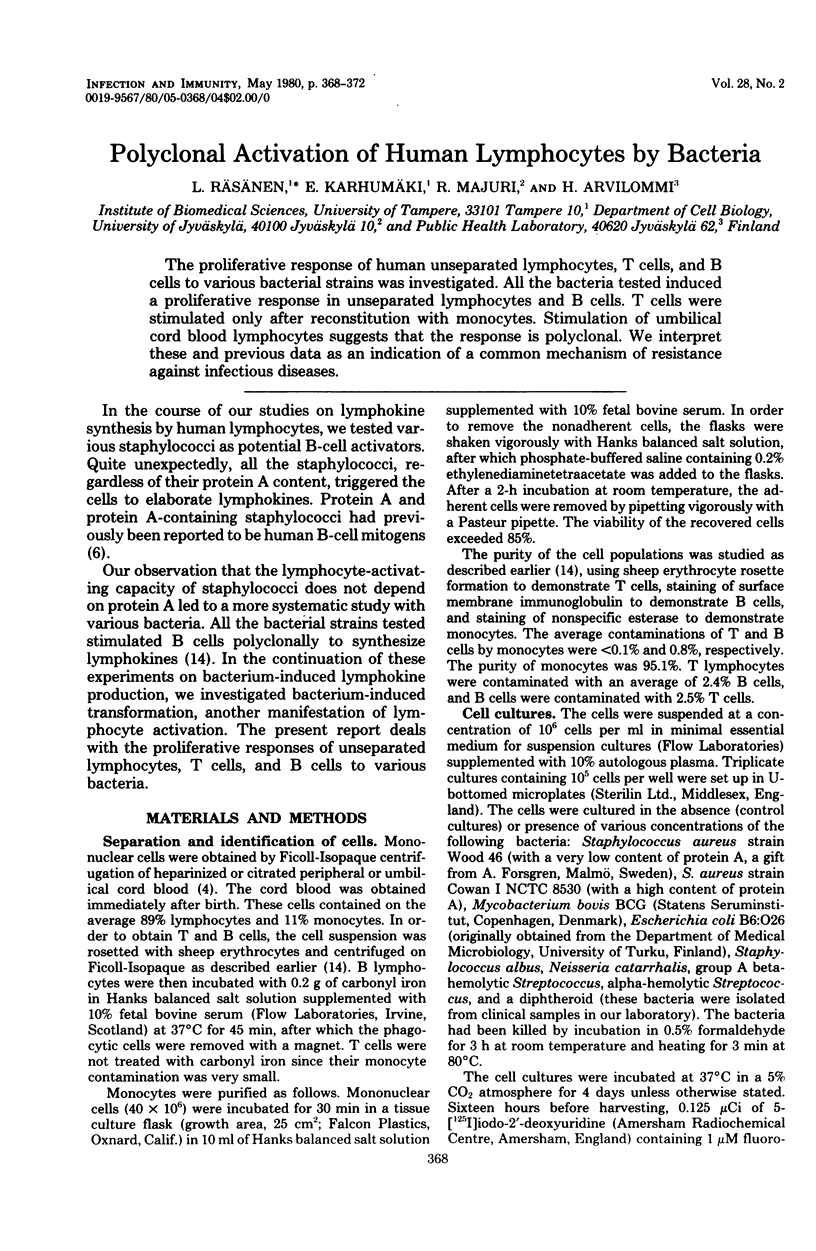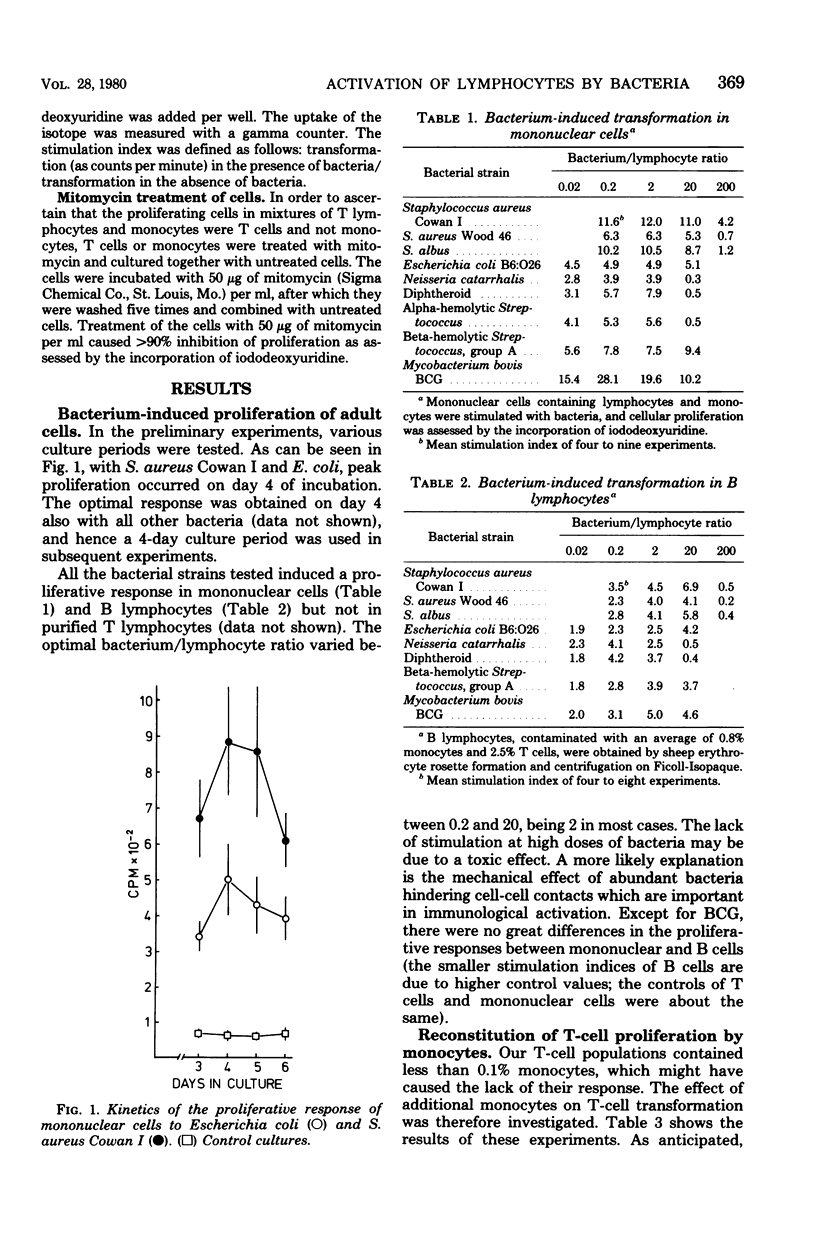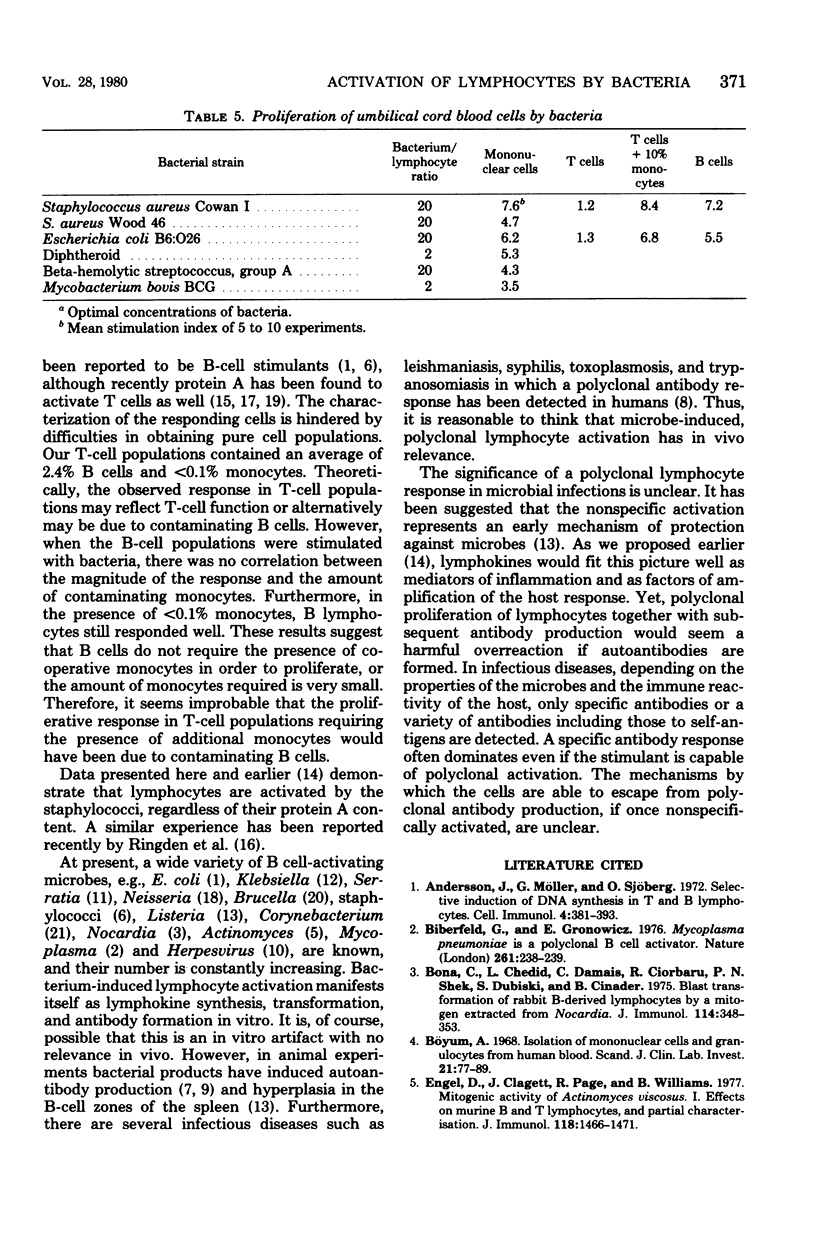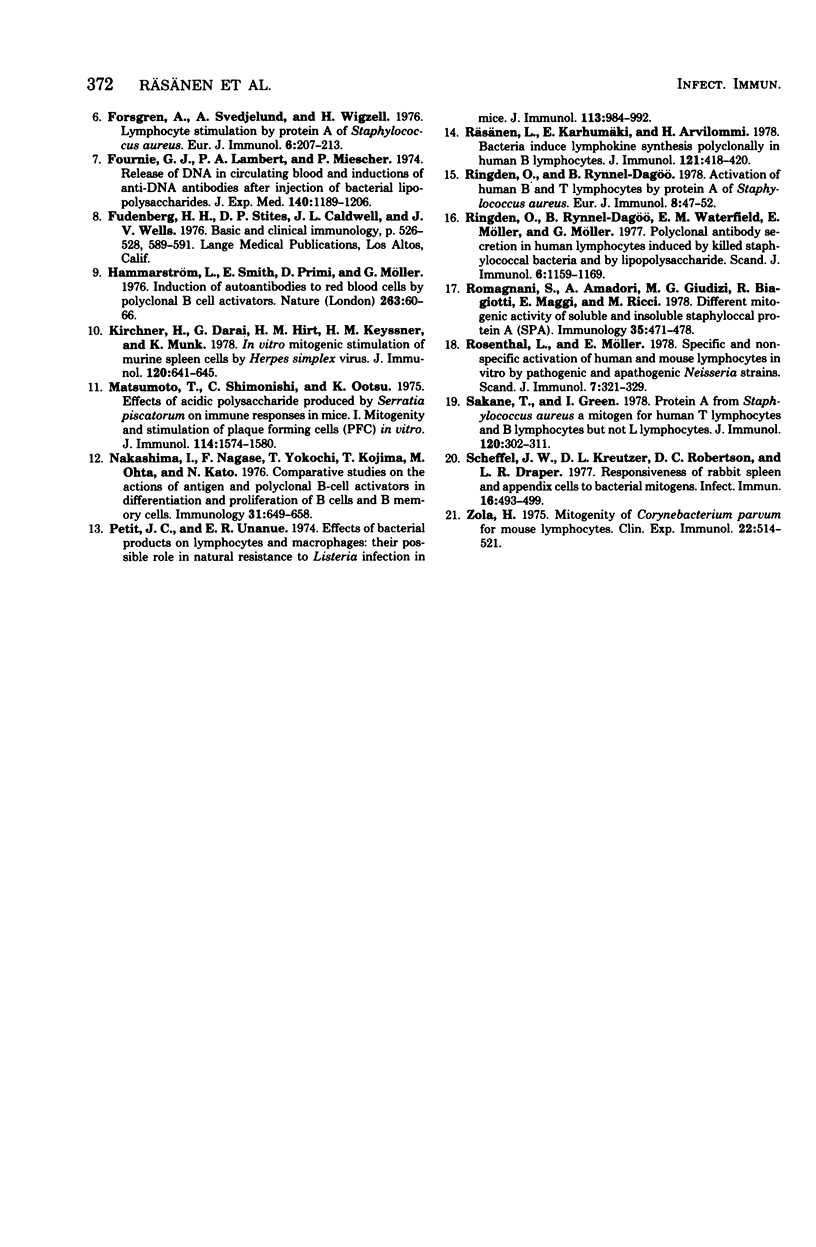Abstract
The proliferative response of human unseparated lymphocytes, T cells, and B cells to various bacterial strains was investigated. All the bacteria tested induced a proliferative response in unseparated lymphocytes and B cells. T cells were stimulated only after reconstitution with monocytes. Stimulation of umbilical cord blood lymphocytes suggests that the response is polyclonal. We interpret these and previous data as an indication of a common mechanism of resistance against infectious diseases.
Full text
PDF




Selected References
These references are in PubMed. This may not be the complete list of references from this article.
- Andersson J., Möller G., Sjöberg O. Selective induction of DNA synthesis in T and B lymphocytes. Cell Immunol. 1972 Aug;4(4):381–393. doi: 10.1016/0008-8749(72)90040-8. [DOI] [PubMed] [Google Scholar]
- Biberfeld G., Gronowicz E. Mycoplasma pneumoniae is a polyclonal B-cell activator. Nature. 1976 May 20;261(5557):238–239. doi: 10.1038/261238a0. [DOI] [PubMed] [Google Scholar]
- Bona C., Chedid L., Damais C., Ciorbaru R., Shek P. N., Dubiski S., Cinader B. Blast transformation of rabbit B-derived lymphocytes by a mitogen extracted from Nocardia. J Immunol. 1975 Jan;114(1 Pt 2):348–353. [PubMed] [Google Scholar]
- Engel D., Clagett J., Page R., Williams B. Mitogenic activity of Actinomyces viscosus. I. Effects on murine B and T lymphocytes, and partial characterization. J Immunol. 1977 Apr;118(4):1466–1471. [PubMed] [Google Scholar]
- Forsgren A., Svedjelund A., Wigzell H. Lymphocyte stimulation by protein A of Staphylococcus aureus. Eur J Immunol. 1976 Mar;6(3):207–213. doi: 10.1002/eji.1830060312. [DOI] [PubMed] [Google Scholar]
- Fournié G. J., Lambert P. H., Meischer P. A. Release of DNA in circulating blood and induction of anti-DNA antibodies after injection of bacterial lipopolysaccharides. J Exp Med. 1974 Nov 1;140(5):1189–1206. doi: 10.1084/jem.140.5.1189. [DOI] [PMC free article] [PubMed] [Google Scholar]
- Hammarström L., Smith E., Primi D., Möller G. Induction of autoantibodies to red blood cells by polyclonal B-cell activators. Nature. 1976 Sep 2;263(5572):60–61. doi: 10.1038/263060a0. [DOI] [PubMed] [Google Scholar]
- Kirchner H., Darai G., Hirt H. M., Keyssner K., Munk K. In vitro mitogenic stimulation of murine spleen cells by herpes simplex virus. J Immunol. 1978 Feb;120(2):641–645. [PubMed] [Google Scholar]
- Matsumoto T., Shimonishi C., Ootsu K. Effects of an acidic polysaccharide procuced by Serratia piscatorum on immune responses in mice. I. mitogenicity and stimulation of plaque-forming cells (PFC) in vitro. J Immunol. 1975 May;114(5):1574–1580. [PubMed] [Google Scholar]
- Mogensen C. E. The glomerular permeability determined by dextran clearance using Sephadex gel filtration. Scand J Clin Lab Invest. 1968;21(1):77–82. doi: 10.3109/00365516809076979. [DOI] [PubMed] [Google Scholar]
- Nakashima I., Nagase F., Yokochi T., Kojima T., Ohta M., Kato N. Comparative studies on the actions of antigen and polyclonal B-cell activator in differentiation and proliferation of B-cells and B memory cells. Immunology. 1976 Oct;31(4):649–658. [PMC free article] [PubMed] [Google Scholar]
- Petit J. C., Unanue E. R. Effects of bacterial products on lymphocytes and macrophages: their possible role in natural resistance to listeria infetion in mice. J Immunol. 1974 Sep;113(3):984–992. [PubMed] [Google Scholar]
- Ringdén O., Rynnel-Dagö Activation of human B and T lymphocytes by protein A of Staphylococcus aureus. Eur J Immunol. 1978 Jan;8(1):47–52. doi: 10.1002/eji.1830080110. [DOI] [PubMed] [Google Scholar]
- Ringdén O., Rynnel-Dagö B., Waterfield E. M., Möller E., Möller G. Polyclonal antibody secretion in human lymphocytes induced by killed staphylococcal bacteria and by lipopolysaccharide. Scand J Immunol. 1977;6(11):1159–1169. doi: 10.1111/j.1365-3083.1977.tb00355.x. [DOI] [PubMed] [Google Scholar]
- Romagnani S., Amadori A., Giudizi M. G., Biagiotti R., Maggi E., Ricci M. Different mitogenic activity of soluble and insoluble staphylococcal protein A (SPA). Immunology. 1978 Sep;35(3):471–478. [PMC free article] [PubMed] [Google Scholar]
- Rosenthal L., Möller E. Specific and non-specific activation of human and mouse lymphocytes in vitro by pathogenic and apathogenic Neisseria strains. Scand J Immunol. 1978 Apr;7(4):321–329. doi: 10.1111/j.1365-3083.1978.tb00460.x. [DOI] [PubMed] [Google Scholar]
- Räsänen L., Karhumäki E., Arvilommi H. Bacteria induce lymphokine synthesis polyclonally in human B lymphocytes. J Immunol. 1978 Aug;121(2):418–420. [PubMed] [Google Scholar]
- Sakane T., Green I. Protein A from Staphylococcus aureus-a mitogen for human T lymphocytes and B lymphocytes but not L lymphocytes. J Immunol. 1978 Jan;120(1):302–311. [PubMed] [Google Scholar]
- Scheffel J. W., Kreutzer D. L., Robertson D. C., Draper L. R. Responsiveness of rabbit spleen and appendix cells to bacterial mitogens. Infect Immun. 1977 May;16(2):493–499. doi: 10.1128/iai.16.2.493-499.1977. [DOI] [PMC free article] [PubMed] [Google Scholar]
- Zola H. Mitogenicity of Corynebacterium parvum for mouse lymphocytes. Clin Exp Immunol. 1975 Dec;22(3):514–521. [PMC free article] [PubMed] [Google Scholar]


